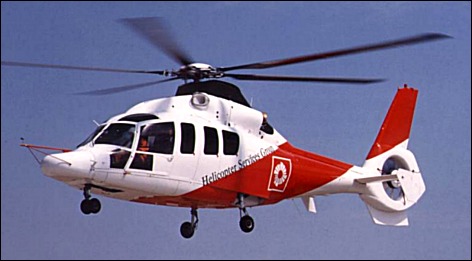
| Eurocopter EC-155 1999 |  |
 |

| Eurocopter EC-155 1999 |  |
 |
|
AS.365N3 with wide 12-passenger fuselage, five-blade main rotor and improved avionics suite. Prot. FF 16 Jun. 1997. Redesignated EC-155. R.Simpson "Airlife's Helicopter and Rotorcraft", 1998
TYPE: Light utility helicopter. PROGRAMME: Programme launched September 1996, as further development of Dauphin 2. Announced at 1997 Paris Air Show, when known as AS 365N4 Dauphin 2. First flight 17 June 1997 as conversion of DGV testbed F-WDFK (see AS 365N Dauphin 2); 1,000 flying hours achieved by February 1998. New, EC 155 designation revealed at HAI convention, February 1998. First production EC 155 (F-WWGZ) flew 11 March 1998. JAR certification received 9 December 1998. FAR certification was due late 1999. Certification for single pilot in IFR issued 25 January 2000. CURRENT VERSIONS: EC 155B: Baseline version; replaced in 2002; MTOW 4,800kg and Arriel 2C1 engines. EC 155B1: Upgraded version from 2002; as described. Features include new engine cowlings, new hydraulic cooling system, chip detectors, cargo fire protection, jettisonable cockpit doors; fixed cockpit footsteps and Thales AHV 16 radar altimeter display. Available with standard Corporate, Offshore and Parapublic equipment packages. EC 155B HTT: Helicoptere Tous Temps (all-weather helicopter). Technology demonstrator (F-WQEZ), first flown 15 October 2002, for evaluation of helicopter navigation, ground collision avoidance and autopilot systems, aimed at relaxation of rules for rotary-wing IFR operations. Equipment includes a GPS/DGPS-based position-finding system which communicates with a ground station at Eurocopter's Marignane facility; four-axis autopilot, permitting steep approaches in zero visibility; and a mission computer with database-stored terrain maps which manages three-dimensional flight plans, coupled with ground collision avoidance system, to ensure safe terrain clearance during en route flight in zero visibility, Mission information is displayed on two large cockpit displays with three-dimensional mapping. Eurocopter expects that the technologies being evaluated in the HTT will be incorporated in its range of helicopters from 2005. CUSTOMERS: First customer, German Border Guard (Bundesgrenzschutz; BGS), ordered 13 for delivery between 16 March 1999 and 2000 and further two in February 2002 for delivery in 2003. German Interior Ministry ordered two for Baden-Wurttemberg regional government in February 2000 for delivery in March 2001; Hong Kong Government Flying Service ordered five of which last delivered 17 December 2002; firm orders stood at 33 by June 2000, of which eight were placed in 1999. Orders in 2000 totalled seven, six of which were placed by Shell Nigeria, whose first aircraft was delivered on 25 September 2001. Swedish Helicopter Service ordered three in June 2001 for delivery between October and December 2002. By October 2001, 44 had been ordered of which 18 were in service. First Nigerian example handed over 26 September 2001. Sales in 2001 totalled 13, including three for COHC (China), two for SFC (Vietnam) and three for SHS (Sweden). Further 13 purchased by BGS in February 2002. DESIGN FEATURES: Compared to earlier Dauphin models, has bulged sliding cabin doors, redesigned cabin windows and 40% larger cabin area. Five-blade Spheriflex main rotor and 10-blade Fenestron rotor with unevenly spaced blades to reduce noise. FLYING CONTROLS: As AS 365N. STRUCTURE: As AS 365N. LANDING GEAR: As AS 365N. POWER PLANT: Two FADEŃ-equipped Turbomeca Arriel 2C2 turboshafts, each rated at 697kW for T-O, 645kW max continuous power and 780kW for 30 seconds. Standard fuel in six tanks, total capacity 1,257 litres; provision for auxiliary tank in baggage compartment, with capacity for 180 litres; or ferry tank in place of rear seats in cabin, capacity 460 litres; refuelling point above landing gear door on port side. Oil capacity 14 litres. ACCOMMODATION: Standard accommodation for pilot and copilot or passenger in front, and three rows of four seats to rear; high-density seating for one pilot and up to 14 passengers; VIP configurations for between four and eight persons in addition to pilot; 12 cabin seats in offshore version, up to six stretchers in casevac role; one crew door and one large sliding door on each side; freight hold aft of cabin rear bulkhead, with door on both sides. Option of hinged cabin door on VIP versions. SYSTEMS: Electrical system includes two starter/generators, each 160 A, 28 V DC and 43 Ah Ni/Cd battery. Duplicated hydraulic system. Optional 10 kVA alternator. AVIONICS: Comms: Corporate: Twin Collins 422A VHF/AM; Collins TDR 94D transponder; NAT AA20-431 passenger address system; Team BA 1920 passenger interphone. Kannad 406AF ELT. Optional Maritime NPX 138, Collins HF 9100 HF/SSB and Collins TDR 94D transponder; Racal CPT 609 ELT. Offshore: Twin Collins 422A; TRD 94D; NPX 138 standard; AA20-431; BA 1920; Kannad 406. Optional second TDR 94D and CPT 609. Parapublic: Twin Collins 422A; TDR 94D; AA20-431; BA 1920; Kannad 406. Optional NPX 138, HF 9100, CPT 609. EQUIPMENT: Standard role packages, included in equipped weight, comprise: Jane's All the World's Aircraft, 2004-2005
|